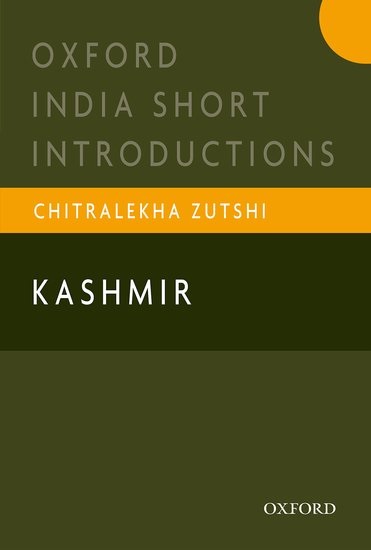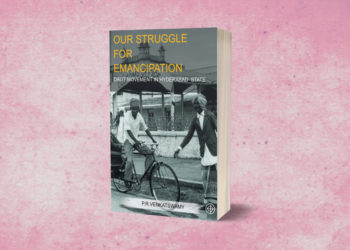Since 1947-48, when India and Pakistan fought their first war over Kashmir, it has been reduced to an endlessly disputed territory. As a result, the people of this region and its rich history are often forgotten. Written by Chitralekha Zutshi, Oxford India Short Introductions: Kashmir, untangles the complex issue of Kashmir to help readers understand not just its past, present, and future, but also the sources of the existing misconceptions about it.
Through the book, the author presents a range of ways in which Kashmir has been imagined by its inhabitants and outsiders over the centuries—a sacred space, homeland, nation, secular symbol, and a zone of conflict. Kashmir thus emerges in this account as a geographic entity as well as a composite of multiple ideas and shifting boundaries that were produced in specific historical and political contexts.
The following are excerpts from the the chapter “The Kashmir Insurgency” of the book.

It is important to remind ourselves of the deeply intertwined nature of separatist and electoral politics in the state of Jammu and Kashmir to understand how we arrived at the current situation in the Kashmir Valley. The participation by Kashmiris in elections, which has grown in recent years, does not imply a decline in separatist sentiments or involvement in separatist politics. Indeed, the last decade has yielded a new kind of resistance to the Indian state alongside new verdicts on the electoral landscape. The lack of resolution of the basic issues related to the insurgency and its impact, especially the continued presence and impunity of the Indian security forces in the Valley, blatant human rights violations within and outside the Valley, combined with rampant mis-governance, corruption, and the inability of state governments to provide basic services, has provided ample cause for young Kashmiri Muslim men and women to participate in the azaadi movement. This has been exacerbated in the context of the rise of Hindu nationalism and anti-Muslim sentiment across India as a result of the BJP central government.
A series of events between 2009 and 2014 were critical in shaping this most recent iteration of homegrown Kashmiri resistance. These events collectively revealed the complicity of the state and central governments in covering up gross violations of the civil and human rights of Kashmiri citizens and thus their indifference to Kashmiri suffering. In 2009, for instance, the rape and murder of two Kashmiri women in Shopian, allegedly by Indian security forces, was mishandled by the state government, with the chief minister, Omar Abdullah, going so far as to deny that these were cases of rape at all. Later in the same year, mass graves of as many as 3,000 victims of the security forces and militants came to light across Kashmir. Again, Abdullah’s government failed to move on providing genetic testing of the bodies to match them with disappeared persons (Tremblay 2018: 231).
[…]
However, the elections yielded a divided verdict across the state, with the PDP doing better than the NC in the Kashmir Valley but not well enough to form a government without a coalition partner, while the BJP emerged as the largest winner in Jammu but with no presence in the Valley (Tremblay 2018: 232–3; see also Tremblay and Bhatia 2015). The PDP–BJP partnership government formed in the wake of the elections in early 2015 institutionalized the Valley–Jammu divide, and being unable to fulfi ll its agenda of alliance that was meant to assuage Kashmiri Muslims through the delivery of good governance, collapsed in 2018.
This collapse was not just because of the vehemence of the most recent round of protests in the Kashmir Valley, which continue unabated to this moment, but because of the fundamentally confl icting views of the PDP and the BJP on Kashmir’s status within the Indian union. While the PDP recognizes the necessity of Kashmir’s autonomy, and thus the symbolism of Article 370, the BJP wants to revoke Kashmir’s special status. By softening their stance on these issues and promising to work together, the two parties ensured that neither of their respective constituencies in the Kashmir Valley or Jammu was satisfied with the coalition government.
As a result, politics continued to radicalize in both regions, with separatists gaining ground in the Valley while Hindu extremists fanned the fl ames in Jammu. Issues such as the resettlement of Kashmiri Pandits in the Valley, a core promise of the BJP to this community, or the banning of beef, provided fodder for both sides to ignite their followers, and not surprisingly, were seen by Kashmiri Muslims as attacks on their very identity and well-being. These fears intensified at the death of PDP’s leader, Mufti Muhammad Sayed, and the instatement of his daughter, Mehbooba Mufti, as chief minister, as Kashmiri Muslims doubted her ability to keep the BJP’s worst tendencies in check (Tremblay 2018: 233–5).
So, in July 2016, when the Indian security forces killed a leader of the Hizbul Mujahideen and one of the most recognizable and celebrated faces of the resistance, a young man named Burhan Wani, Kashmiri youth once again erupted onto the streets, pelting stones and demanding azaadi. As the Indian state responded with characteristic brutality, blinding young people and bystanders with pellet guns and filling jails, Kashmiris vowed that this time they would not back down. Shuttering their shops and businesses, boycotting offices and workplaces, the older generation joined hands with their younger compatriots, willing to sacrifice livelihood and life, even the lives of their own children, for freedom. The resistance had been radicalized to such an extent that it had taken on a life of its own, beyond organizations that were regarded as too accommodative and beyond political solutions. For the young people on the streets, the only endpoints were, and continue to be, freedom or martyrdom.
As we have seen, Kashmiris have been celebrating their land as well as expressing their anger, frustration, and deep sorrow at its destruction through the narrative medium throughout their past. This continued during the insurgency, when a slew of poems captured their mood and recorded their traumas as the movement spiralled into a cycle of violence (Kaul 2015: 135–61). The most recent intifada has also found expression in poetry, not surprisingly especially in rap, to match its spontaneity and close relationship to the street. A well-known rapper, M.C. Kash, for instance, freestyles about the Kashmiri situation thus:
Keep knocking on my door every night
Looking for a rebel in the eyes of my child
They’re blind to the innocence
Murder all the innocents
Rising up to prominence
Hiding all the evidence
Scared of the dissidents
The common sense is to
Brutally suppress all voices or
Shoot pellets to blind
Keep knocking on my door every night … (Kash n.d.)
This is the cry not of a victim, but a rebel, mobilizing others to join the resistance.




